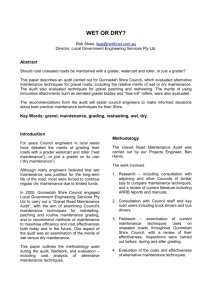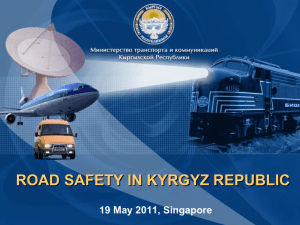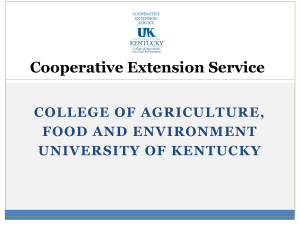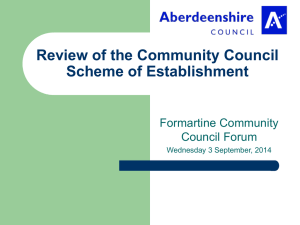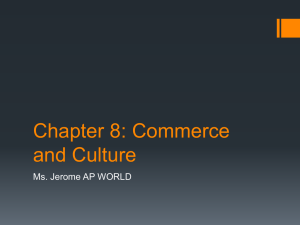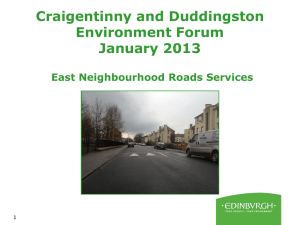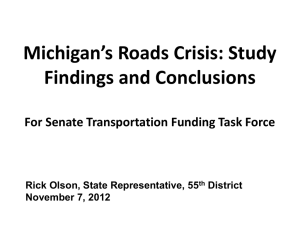Roads and Works Conference - Local Government Association of
advertisement
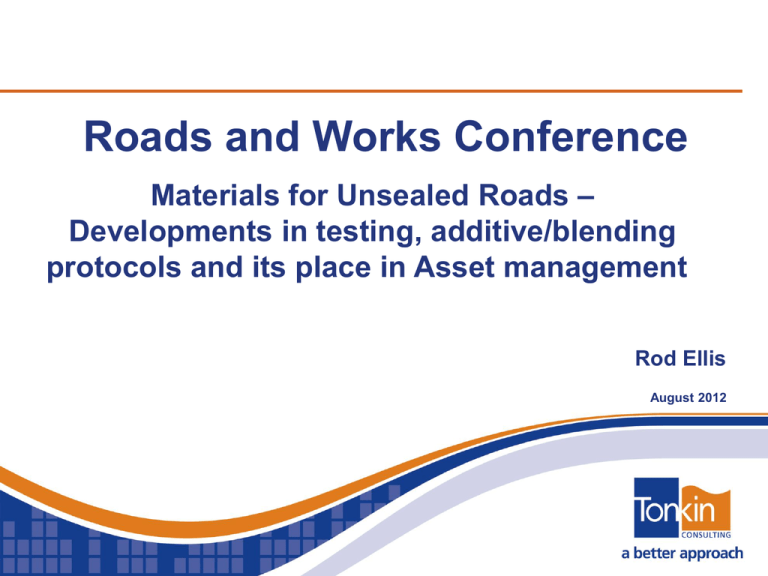
Roads and Works Conference Materials for Unsealed Roads – Developments in testing, additive/blending protocols and its place in Asset management Rod Ellis August 2012 Introduction • Local Government Research and Development Scheme 2009 2012 • Trialing new techniques for improving the composition of material used for unsealed roads Outcomes • Results of the 3 trial sites monitored over 3 years • Protocol in the assessment process and decision making for material selection • Monitoring forms and process • Whole of life considerations Purpose • To better understand what makes a good material for unsealed roads (before it is used) • To acknowledge the large volumes of material used in unsealed road construction and to attempt to become smarter by introducing some science to compliment practical experience • Acknowledge some Councils Works Managers will not have years of local experience so setting up a framework and knowledge base to assist good decisions in material selection and treatment is critical for future success Trial Process • Pit Material testing against ARRB specifications • Assess options to improved material properties – Blending – Additives – Adapting works practices • Examine Whole of Life benefits of various treatments • Setup and monitor trial sites • Recording findings and reporting Adelaide Hills Councils • Dolomite and Monarto Material • Polycom in sections • Monarto, slightly finer grading ,less loose material and wear Goyder • Drews Pit – 5 sections • Polycom, Lime, Import material, bag lime in sections, untreated • Imported material to PM specification higher loose material and windrow development • Lime not effective for low PI material • Polycom seemed to work with the fines to reduce windrow development and loose material. Loxton Waikerie • Lowbank Road • Dustcheck use to reduce dust • No observable dust reduction • Less rutting, windrow generation and loose material where additive used Pit Material • Key Learning 1 Local Government need to recognise the difference between commercial products for base course, sub base course and material from pits for sealed roads to those attributes which contribute to a good wearing surface for unsealed roads. 100 90 Percent Finer 80 Unsealed Road 70 60 50 40 30 Sealed Road 20 10 0 0.01 0.1 1 Particle Size (mm) 10 100 Key Learnings Where we want to get to Key Learning • Key Learning 2 • • • Improve raw material before using additives Clear specification for grading and plasticity Pit operators need to blend stone, gravel and fines in proportion to develop acceptable material The Thirds Rule 100 90 80 Percent Finer 70 60 50 40 30 20 10 0 0.01 0.1 1 10 Particle size mm 0.5mm 10mm 100 Blending at the Pit Use of testing information 10 50 10 230 500 450 Sandy clays Clayey gravels D 50 10 Slippery 400 50 38 Shrinkage Product More Clayey 350 300 250 E A C Good Erodible Ravels 200 Silts 150 Silty gravels 100 Sands 50 Sandy gravels B Corrugates and ravels 0 0 2 4 6 8 10 12 14 16 18 20 22 24 26 28 30 32 34 36 38 40 Grading Coefficient More Gravel 42 44 46 48 Key Learning Key Learning 3 • • • Properties in the pit will be different on the road. Select the right equipment to suit the material Test post compaction from the road to determine compliance to grading and Plasticity When to Grid Roll/Rock bust When to crush and raw feed composition Blending on the Road Bed Additives » Key Learning 4 » For Drews Pit material at Goyder in hindsight the use of lime was inappropriate, however lime/fly ash may be an alternative in future trials. » Key Learning 5 » Polycom needs fines in the material to work. Further monitoring is recommended for each Council to determine if there is longer term benefits. After 2 years of monitoring there are positive indicators. Monitoring • The monitoring methodology used was deliberately made simple to allow Councils field staff. In all cases the field record sheets were designed to allow for a systematic and consistent approach to record keeping • The visual assessment observed Dust, Corrugation, Potholes and Loose Material on a course rating of LOW, MEDIUM and HIGH. • The site measurement assessment consisted of: – depth of rutting depth (mm) – window height (depth) mm – loose material (kg/0.5m2) – Corrugations (depth mm, spacing (m)) Monitoring Monitoring Key Learning 6 Dust assessment discernment is very difficult visually. The extent of humidity at time of assessment i.e. overcast, clear or recent rain needs to be recorded. Key Learning 7 While visual assessment of loose material may not be discernible, the measurement of windrow height and loose material are more indicative. Key Learning 8 Trial sites should be left without maintenance grading interventions if possible to develop a longer term trend of deterioration. Several Councils undertook grading operation during the trial period. Typical results WHOLE OF LIFE WHOLE OF LIFE Protocol for Unsealed Road Performance Protocol for Unsealed Road Performance Application to the wider local government Promotion Roads Conference and SALGSOA groups Get other Councils involved Kingston and Kangaroo Island are planning trials Support Tonkin/ARRB through Rod Ellis and Bob Andrews Tools – Grading Assessment Tools – Material performance Charts – WOL Spreadsheets – Field Trial monitoring forms – Reporting Framework Upskilling Relating to Asset Management 47700 km of sheeted roads over 45 rural Councils $1.1 Billion Dollar asset in sheeted roads across the state $51 Million dollar annual re-sheeting across the state $1.1 Million dollar average re-sheeting /rural Council Road Hierarchies Asset Life linked to service standards and associated costs example Rate Resheet percent resheet *percent life life*per cent cat1 35000 25 875000 12 300 cat2 28000 20 560000 15 300 cat3a 22000 15 330000 25 375 cat3b 18000 25 450000 30 750 cat3c 15000 15 225000 35 525 100 2440000 Ave Resheet $ 24,400.00 2250 Ave Life 22.5 Life Extension Impact across the state example Saving for State with each extra year life average/Cou ncil (assume 45 Councils) Average Saving for Council Percen t saving km in the State $$/km Value of States sheeted roads Avera ge life Total Annual Resheeting Cost for State 47678 24400 1,163,332,586 22.5 51,703,670 47678 24400 1,163,332,586 23.5 49,503,514 2,200,156 1,100,078 48,892 4% 47678 24400 1,163,332,586 24.5 47,482,963 4,220,708 1,055,177 93,794 9% 47678 24400 1,163,332,586 25.5 45,620,886 6,082,785 1,013,797 135,173 13% 47678 24400 1,163,332,586 26.5 43,899,343 7,804,328 975,541 173,430 18% 1,148,970 Life extension Hypothetically how can 4 year increase life be achieved example based on percentages in previous slide life life comment cat1 12 15 Improve Material Properties cat2 15 19 Improve Material Properties cat3a 25 28 both material and service level cat3b 30 35 both material and service level cat3c 35 40 Review service levels 22.5 26.5 4 years increase in life AVERAGE Benefit to Asset Management An Average 4 year life increase across network can result in $175,000/annum/Council less re sheeting (18% saving) Average for 45 Councils/annum $1,400,000.00 Annual resheeting cost $1,200,000.00 $1,000,000.00 $800,000.00 av/Council $600,000.00 Saving $400,000.00 $200,000.00 $22.5 23.5 24.5 Ave Life 25.5 26.5 Shift from this To this



